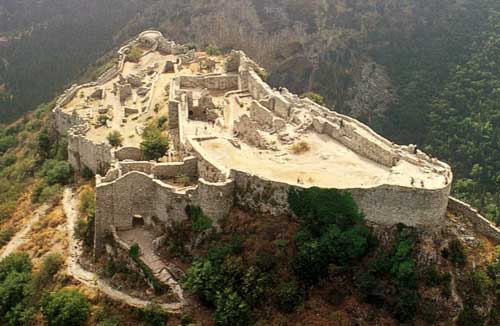 |
| The Castle of Mystras |
 |
| Inside one of Mystras's many Medieval Churches |
William II was the ruler of the Frankish Principate of Achaia. Here he founded his principality in Greek Byzantium after the fall of Constantinople in 1204. After the fall of Monemvasia in 1248 this knightly foreign prince lost no time extending his power deep into ancient Laconia, successfully establishing his dominion over the whole Peleponnese. The Chronicle of Morea states:
'he found a curious hill, an outcrop of the mountain ...and he gave orders and upon the hill they built a castle/ and they called it Myzethra, because thus the people cried out its name:/ a splendid castle he made it and a mighty stronghold.' (lines 2985-2991)
 |
| Pantanassa |
Sadly the Franks were defeated at The Battle of Pelagonia in 1259 and William was taken prisoner. To buy his way out of a Turkish prison he ceded the castles of Monemvasia, Mani and Mystras to the Turks. It was unfortunate for him that, by the time he purchased his freedom, the Franks had already retaken all of his fortresses! Consequently for the following decades there were struggles between the two groups of people, Franks and Turks. The Turks put their own governor in charge of the city. None the less, the Franks kept regaining their territory until by the mid fourteenth century emperor John VI Cantacuzenus took stronger measures and sent his second son Manuel to the Peloponnese with the title and authority of Despot. As a consequence, a brilliant period of Byzantine renaissance followed in Mystras.
 |
| The Walls |
During Mystras's Frankish rule, a town grew up around the castle because many inhabitants of the surrounding area came to the fortress for protection. In 1265 the Cathedral of Ayios Demetrius was built. By 1290 there were the Monastery of Brontochion and the church of Ayioi Theodori and that of Aphentiko just outside the town wall. The walled town itself contained a magnificent Palace and the dwellings of officials, magistrates and burghers. |
| Ayia Sophia |
Exploring the ancient city takes easily three hours and every time I visit I take different routes around Mystras and always discover new things. The art in the many churches alone, the frescos and the fabric of these churches and the monastery provide a visual voyage. If you were to visit this site, bring a few snacks and a water bottle and during midsummer do set out very early. Midday in summer is exacting for the most intrepid traveller. Wear sensible shoes and a sun hat is indispensable. You will climb, explore and lose yourself here.
 |
| One of the hundreds of wall paintings |
During the last centuries of the Byzantine empire, Mystras saw restoration and external threats, internal upheaval. Yet it remained important, the haunt of artistic and intellectual eminence. Mystras also became the centre of military campaigns and diplomatic intrigue as the Franks of Arcadia lost control. After the Turks finally controlled the region, Mystras had direct links with Constantinople. This was to the city's advantage since it became a centre for philosophers, historians, painters, bibliographers who brought a high level of sophistication to the area. It became a city in which indigenous Greeks, Franks, Despots who intermarried with prominent European Houses, dwelled together in relative harmony.
 |
| The Monastery Entrance |
By the fifteenth century the Venetians attempted to capture the city but initially failed. They brought silk production and with that prosperity to a town of around 40,000 inhabitants. Mystras was finally taken by the Venetians in 1687 who held it for decades until the Turks recaptured it during the second decade of the eighteenth century. Following its recapture Mystras had a chequered history until the new town of Sparta was established during the nineteenth century and the medieval city was finally abandoned. |
| Monastery of Peribleptos |
 |
| St George |
 |
| My cousin sharing a moment with the cats of Peribleptos |
 |
| Our lovely friend and guide Spyros took us to ancient Sparta on this visit, another 'must see' and off the well-trod tourist track |
Carol McGrath is the author of The Handfasted Wife, the story of Edith Swan-Neck, King Harold's Handfasted Wife published by Accent Press and first novel in a trilogy entitled The Daughters of Hastings.
.jpg)


.jpg)